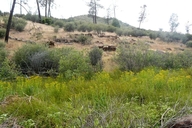Taxon Details
Senecio clevelandii var. heterophyllus
Red Hills ragwort
View Report Copy Link Calflora eFlora CCH CalPhotos iNaturalist
Taxon Summary:
Senecio clevelandii var. heterophyllus, commonly known as Red Hills ragwort, is a perennial herb in the Asteraceae that is found only in California. It occurs within Cismontane woodland (seeps, and serpentinite), growing at elevations from 260 to 385 meters. Senecio clevelandii var. heterophyllus is ranked 1B.2, Plants Rare, Threatened or Endangered in California and Elsewhere; Moderately threatened in California.|
Scientific Name: Senecio clevelandii Greene var. heterophyllus Hoover |
||
|
Common Name: Red Hills ragwort |
||
| Family: | Asteraceae | |
| Element Code: | PDAST8H0R2 | |
| USDA Plants Symbol: | ||
|
Synonyms/Other Names: |
||
| Name Status: |
JEF, FNA, POWO, IPNI, Tropicos |
|
| CA Rare Plant Rank: | 1B.2 |
| Fed List: | None |
| State List: | None |
| Global Rank: | G4?T2Q |
|
State Rank: |
S2 |
| Other Status: | BLM_S; SB_SBBG |
|
CRPR Changes: |
|
| Add Date: | 1994-01-01 |
| Date Edited: | 2025-10-29 |
| Lifeform: perennial herb | ||||||||||||||
Blooming Period: May-Jul
|
||||||||||||||
|
Elevation:
260 - 385 meters 855 - 1265 feet |
||||||||||||||
General Habitats:
|
||||||||||||||
| Microhabitat Details: | ||||||||||||||
|
Microhabitat:
|
||||||||||||||
|
Notes: Known only from the Red Hills (TUO) and protected at Red Hills ACEC (BLM) |
|
|
Threats: Possibly threatened by grazing, recreational activities and foot traffic. |
|
|
Taxonomy: A synonym of Senecio clevelandii in The Jepson Manual (1993) and Packera clevelandii in the Jepson eFlora (2012). See Leaflets of Western Botany 2:132 (1938) for original description and Phytologia 49(1): 44-50 (1981) for revised nomenclature. |
|
| Threat List Total: | 8 | |
| Total EOs | % of EOs | |
| EOs with Threat Listed: | 9 | 75 % |
| THREAT LIST: | ||
|---|---|---|
| Other | 7 | 58% |
| Improper burning regime | 6 | 50% |
| Foot traffic/trampling | 6 | 50% |
| Recreational use (non-ORV) | 5 | 41% |
| Altered flood/tidal/hydrologic regime | 4 | 33% |
| Grazing | 3 | 25% |
| ORV activity | 2 | 16% |
| Development | 1 | 8% |
| Total Occurrences: | 12 | ||||
| Element Occurrence Ranks: | |||||
|---|---|---|---|---|---|
| A | B | C | D | X | U |
| 4 | 6 | 0 | 0 | 0 | 2 |
| Occurrence Status: | |||||
|---|---|---|---|---|---|
| Historical >20 Years | 6 | ||||
| Recent <=20 Years | 6 | ||||
| Presence: | |||||
|---|---|---|---|---|---|
| Presumed Extant | 12 | ||||
| Possibly Extirpated | 0 | ||||
| Presumed Extirpated | 0 | ||||
| California Endemic: | |||||||||||||
| California Island: | |||||||||||||
|
States: Name (Code) California (CA) |
|||||||||||||
|
California Counties and Islands: Name (Code) Tuolumne (TUO) |
|||||||||||||
|
Quads: Name (Quad Code) Chinese Camp (3712074), Keystone (3712075), Moccasin (3712073), Sonora (3712084) |
|||||||||||||
Notes:
|
|||||||||||||
 Presumed Extant
Presumed Extant
Click on quad for name. Hold Shift Key to use mouse scroll wheel



